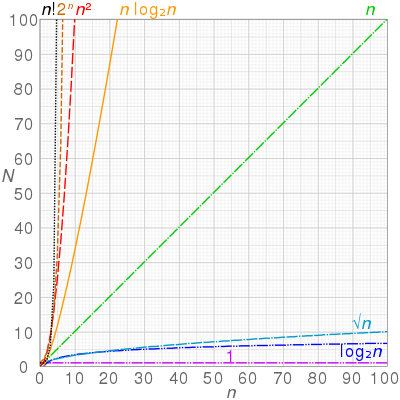Algorithms and Data Structure: Introduction
Published:
An algorithm refers to a sequence of instructions designed to solve a particular problem, whereas a data structure refers to a way of organizing and storing data in a computer to ensure efficient access and modification. Programming involves implementing algorithms and data structures, and their utilization greatly impacts system performance.
Measuring Algorithm Performance
- Method
- Experimental (Machine-Dependent): measure the execution time of a program
- Analytical (Machine-Independent): measure the number of steps of execution
- Evaluation metric of analyitical approach: Complexity
- Space complexity: Required memory size (static+dynamic)
- Static: predetermined size by a program
- Dynamic: varies depending on the number of input data
- Time complexity: The number of steps of execution. We care about both the average and the worst (longest).
- Both complexities are functions of the number of input data sizes, up to the leading order: Big O expression,
O(n)
- Space complexity: Required memory size (static+dynamic)
Big O Notation
The “O” in Big O notation is used to describe the upper bound of an algorithm’s running time. Big O notation only provides an upper bound on an algorithm’s running time, and actual running times may be faster in practice.
O(1): Constant.O(log n): Logarithmic growth.O(n): Linear growth.O(n log n): Log-linear or superlinear growth.O(n^2): Quadratic growth.O(n^3): Cubic growth.O(2^n): Exponential growth.O(n!): Factorial growth.

Big-Ω (Big-Omega) notation
Big-Omega refers to the lower bound of time or space complexity of an algorithm, meaning it is the best runtime scenario. Or runtime could worse than Big-Omega, but it will never be better.
Big-θ (Big-Theta) notation
Big-Theta refers to the tight bound of time or space complexity of an algorithm. Another way to think of it is the intersection of Big-O and Big-Omega, or more simply runtime is guaranteed to be a given complexity, such as n log n.
Memory structure for a program
Once you execute a program, the program is loaded into the memory. Then processor read data and commands in memory to operate. The memory allocated during this process has the following structure.
- Code: For code (execution commands). The memory size is fixed at compile. The memory is allocated (released) at the beginning (end) of the program.
- Data: For global, static variables. The memory size is fixed at compile. The memory is allocated (released) at the beginning (end) of the program.
- Heap: For dynamic memory allocation. The memory size changes over runtime.
- Stack: For local variables and parameters. The memory size is fixed at compile. The memory is allocated (released) when a function is called.
Where the choice of a data structure makes a difference?
- Memory size
- Speed at creation
- Speed of insertion/deletion of a node
- Speed of search